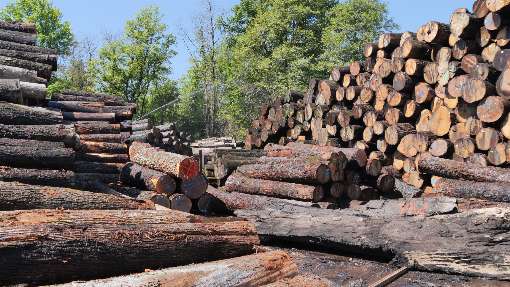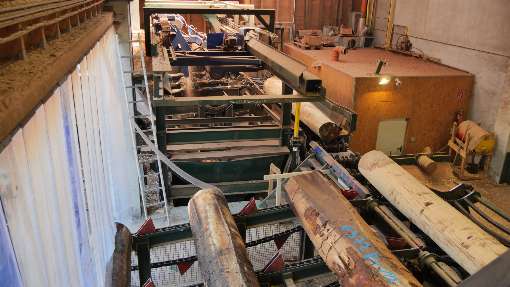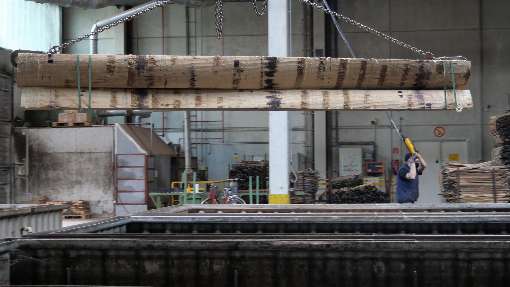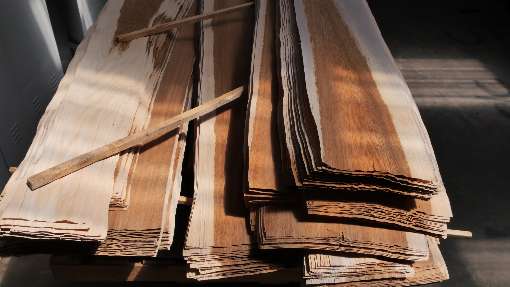09.05.2022
Not every tree is suitable
Bonn. For a veneer manufacturer, not all trees are the same. He often has to travel a long way to find the right specimens. But it is also a long way from the right tree to fine veneer. Appropriately processed, what at first glance appears to be a normal and ordinary trunk becomes real art for just about anything that can be veneered.
Several types of wood are suitable for the production of veneer: Beautiful veneers are made from the wood of maple or beech. But also oak, ash and walnut are perfect sources for special and unique veneers. The selected trees are cut in winter. Because then there are only a few shoots and the wood is quite dry. Once at the veneer mill, the logs are stacked on top of each other and properly watered. As soon as the wood has absorbed enough moisture, the trees are debarked. Their wood is now easier to work with and, depending on the veneer look to be achieved, can be sliced, peeled all around like an apple, or roughened with a special saw. "The subsequent use of the veneer also determines how thick it will be. Normally, veneer sheets with a thickness of around 0.45 millimeters to about 6 millimeters are produced. At the request of the customer, however, we also deviate from this," says Ursula Geismann, a long-time living analyst and managing director of the Initiative Furnier + Natur (IFN).
Further drying, quality selection and cutting follow
The freshly produced veneer sheets must be further dried slowly and carefully in the ongoing production process. Otherwise they can become wavy or crack. This is followed by selection according to quality and grade, as well as final cutting to the previously specified size. "The resulting individual parts are finally either processed further as they are or they are assembled into so-called 'decks,'" Geismann explains. These decks are applied to particleboard, MDF, multiplex board, plywood or solid wood stickboard using glue and high pressure, among other methods. What then follows is the transformation of normal everyday objects into small and large works of art: from small treasures such as reading glasses made of veneer, a finely grained mouse pad or a business card, to cool skis, kite boards and even classy, handmade handbags, to chic sinks and bathtubs for upscale living styles or cool, veneered designer furniture for nature-loving individualists. (DS)
Further information on the subject of veneer at www.furnier.de oder www.furniergeschichten.de
facebook
linkedin
instagram
Visuals:
Photo 1:Veneer trees before further processing. Photo: IFN/Mehling & Wiesmann
Photo 2: In the factory, the tree is turned into the finest veneer. Photo: IFN/Schlautmann
Photo 3: Veneer log in lofty heights. Photo: IFN/Schlautmann
Photo 4: The veneer sheets are waiting for further processing. Photo: IFN/Mehling & Wiesmann
May 9. 2022
Not every tree is suitable
The long road to fine veneer
Bonn. For a veneer manufacturer, not all trees are the same. He often has to travel a long way to find the right specimens. But it is also a long way from the right tree to fine veneer. Appropriately processed, what at first glance appears to be a normal and ordinary trunk becomes real art for just about anything that can be veneered.
Several types of wood are suitable for the production of veneer: Beautiful veneers are made from the wood of maple or beech. But also oak, ash and walnut are perfect sources for special and unique veneers. The selected trees are cut in winter. Because then there are only a few shoots and the wood is quite dry. Once at the veneer mill, the logs are stacked on top of each other and properly watered. As soon as the wood has absorbed enough moisture, the trees are debarked. Their wood is now easier to work with and, depending on the veneer look to be achieved, can be sliced, peeled all around like an apple, or roughened with a special saw. "The subsequent use of the veneer also determines how thick it will be. Normally, veneer sheets with a thickness of around 0.45 millimeters to about 6 millimeters are produced. At the request of the customer, however, we also deviate from this," says Ursula Geismann, a long-time living analyst and managing director of the Initiative Furnier + Natur (IFN).
Further drying, quality selection and cutting follow
The freshly produced veneer sheets must be further dried slowly and carefully in the ongoing production process. Otherwise they can become wavy or crack. This is followed by selection according to quality and grade, as well as final cutting to the previously specified size. "The resulting individual parts are finally either processed further as they are or they are assembled into so-called 'decks,'" Geismann explains. These decks are applied to particleboard, MDF, multiplex board, plywood or solid wood stickboard using glue and high pressure, among other methods. What then follows is the transformation of normal everyday objects into small and large works of art: from small treasures such as reading glasses made of veneer, a finely grained mouse pad or a business card, to cool skis, kite boards and even classy, handmade handbags, to chic sinks and bathtubs for upscale living styles or cool, veneered designer furniture for nature-loving individualists. (DS)
Further information on the subject of veneer at www.furnier.de oder www.furniergeschichten.de
Visuals:
Photo 1:Veneer trees before further processing. Photo: IFN/Mehling & Wiesmann
Photo 2: In the factory, the tree is turned into the finest veneer. Photo: IFN/Schlautmann
Photo 3: Veneer log in lofty heights. Photo: IFN/Schlautmann
Photo 4: The veneer sheets are waiting for further processing. Photo: IFN/Mehling & Wiesmann
May 9. 2022

Photo 1:Veneer trees before further processing. Photo: IFN/Mehling & Wiesmann

Photo 2: In the factory, the tree is turned into the finest veneer. Photo: IFN/Schlautmann

Photo 3: Veneer log in lofty heights. Photo: IFN/Schlautmann

Photo 4: The veneer sheets are waiting for further processing. Photo: IFN/Mehling & Wiesmann